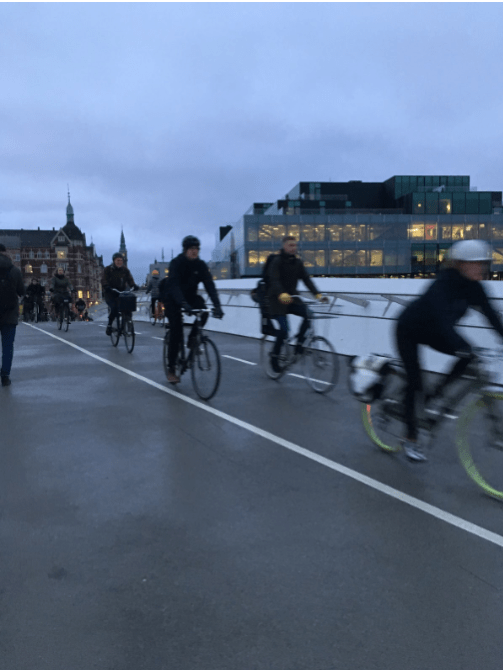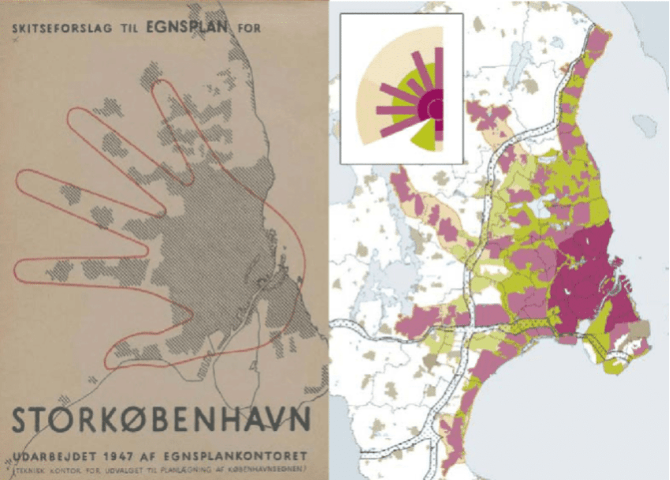Biking is Freedom – Local Perspectives on Alternative Transportation in Copenhagen
Goddag!
To delve into my topic of alternative transportation a little further this week, I conducted a few interviews: one local expert and two friends who are also study-abroad students in Copenhagen to get a range of perspectives.
I’m taking a class called Integrated Climate Change Planning, which focuses on the potential for cities to mitigate carbon emissions, as well as some of the challenges facing the integration of climate change concerns into urban planning efforts. My professor, Silvia, was kind enough to sit down with me to talk about her experiences as an architect and urban planner working in Copenhagen. She has also lived in several other European cities, so she has a very holistic understanding of how transportation varies and the impacts it has on people’s lives.
We talked a lot about the history of the public transit system in Copenhagen, and how the design of the city has made it conducive for people to take public transportation. As I mentioned in my last post, Copenhagen is structured around the finger-plan, centered around a high density area with access to necessities and a lot of mobility by walking and biking. Branching off from the center are “fingers” that extend train lines towards the suburbs to allow commuters accessibility to the city and the option to bring a bike along for free. Silvia explained that this model was adopted by Copenhagen in 1947, right after World War II, and was made possible only because there is no automobile or big oil industry in Denmark to lobby against the implementation of more public transportation. In other countries with a strong economic dependence on the car industry or oil, this sort of transition wouldn’t have happened.
We also discussed the many benefits of using alternative transportation methods, particularly biking, something Silvia is really passionate about. She admitted that being able to bike everywhere is one of her favorite things about living in Copenhagen. Biking is great not only for efficiency purposes, but also because it saves money, reduces carbon emissions, and improves mental and physical health. When she doesn’t have the option to commute outside, interacting with her environment and the people around her, Silvia said “she can feel it on her own skin.”

Bikers at rush hour in Copenhagen.
My friend Bronwyn agrees: “I enjoy biking everywhere. It makes me feel good about myself.” We discussed a podcast she listened to that investigated the connection between negative health outcomes in the U.S. and our common forms of transportation, namely driving cars. The way that our transportation infrastructure was designed, forcing us to sit in our cars for hours a day, is contributing to our country’s unhealthy habits. In Denmark, the emphasis on moving and getting outside is having tangible positive health impacts on the population. And, given that Denmark has a strong welfare system including universal health care, encouraging habits that lead to healthier populations is in everyone’s best interest.
Being a visitor in this city, it’s easy to feel like an outsider, but during the interview with my roommate Sarah, she highlighted the fact that biking has helped her adjust to living in Copenhagen. “I feel more integrated as a part of the city because we have the opportunity to bike, which is what the locals do. I truly believe that biking is an incredible way to experience all that is around you while transporting yourself more efficiently than walking.” Because biking is so central to Danish culture and the whole Copenhagen experience, being a part of that has allowed me and many other students here assimilate. Just another way that transportation brings people together, a point Silvia made over and over.
Commuting to school or work by bike, while sometimes sweaty, is a privilege that isn’t available in most other places. “Cars are considered freedom? I don’t get that.” Silvia was adamant that driving the same route everyday while sitting in “a metal box” stuck in traffic is anything but freedom. When we are limited in our options of how we move around, we don’t have the same opportunities as those who have more transportation choices. Instead, having proper infrastructure and many types of transit to choose from are what really provide us with freedom. If the train isn’t running, we can take the metro or bus, or we can bike or walk. When driving is our only option, we are quite limited and are forced to move around in a way that is harmful to us as individuals and as a society. “[Having a variety of transportation options] just makes so much sense. Economically it makes sense to do the sustainable thing.”
As an architect by training, Silvia made sure to underscore the importance of intentional design in creating urban spaces that allow residents to have the freedom to choose how they get around. “The way we design has a big impact on our mobility choices,” she said. In Copenhagen, the city is growing alongside the development of more public transit (the metro specifically, as I discussed last time). This allows more room for innovation, social interactions, and just life to go on in general because as people move, they have ways to get back to the center. This design model is also one of the reasons Copenhagen has been able to pursue goals of carbon neutrality, because expanding transit in line with the expansion of the city allows for more control over the distribution of energy and influences mobility tremendously. Silvia mentioned that in London, the city is playing catch-up with public transportation; the city expanded much quicker than transit did and as a result, people are experiencing limited mobility options, forcing a reliance on cars. As exemplified by Copenhagen, we need to invest time, effort, and resources during the city-planning stages in order to get the transportation outcomes that we want.
Sarah, one of my roommates, seconds this opinion. remarking that she loves how Copenhagen is so people-centered. She reflected on how impressed she is that when looking up directions throughout the city, Google Maps consistently lists biking as the most efficient option. “I’m proud of Copenhagen in that modes of transportation are supported that genuinely make people happier.” Living here for two months, I definitely see where she is coming from and I can appreciate how easy biking is in this city.
My discussions with Silvia and friends from abroad highlighted the overall positive attitudes towards having a wide range of public transportation options available in Copenhagen. People love the freedom associated with living in a bikeable city and appreciate the intentionality with which Copenhagen has designed its transportation infrastructure. Silvia’s parting words were, “Don’t take anything for granted, and recognize that everything is designed. Those are my overall pieces of advice.”
Until next time, design intentionally!
Rebecca

